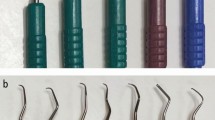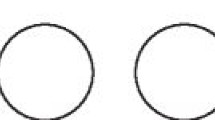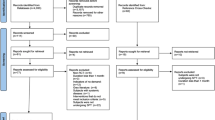Abstract
Data sources Data sources were Medline, the Cochrane Controlled Trials Register, Biosis, EMBASE, Health Devices Alerts, Meditec, Russmed articles and Scisearch dated up to April 2001, and reference lists from relevant articles.
Study selection Randomised controlled trials were selected if they had at least 6 months’ follow-up and compared machine-driven instruments with hand instruments for the treatment of chronic periodontitis.
Data extraction and synthesis Information regarding the quality and characteristics of studies was extracted independently by two reviewers. Kappa scores determined their agreement. Prevention of tooth loss was the primary outcome, with secondary outcomes of prevention of disease progression, resolution of anatomical defects and resolution of gingival inflammation also considered. Efficiency was assessed as the mean time needed to treat one tooth. Qualitative synthesis was conducted for all outcomes except time needed to treat one tooth, where a meta-analysis was performed.
Results Thirteen studies were included in the review. No study reported on the selected primary outcome variables. Using the outcome variables of clinical attachment gain, probing pocket-depth reduction or bleeding on probing-reduction, there appeared to be no differences between ultrasonic/sonic and manual debridement. No major differences in the frequency or severity of adverse effects were found. Ultrasonic/sonic debridement was found to take significantly less time, ie, 36.6% of the time for debridement using hand instruments.
Conclusions Ultrasonic/sonic subgingival debridement requires less time than use of hand instruments. The data did not indicate a difference between ultrasonic/sonic and manual debridement for the treatment of chronic periodontitis for single-rooted teeth but the evidence is not very strong. High quality trials are needed to assess the efficacy of machine-driven subgingival debridement. Clinical outcome variables that have a tangible benefit to the patients should be used.
Similar content being viewed by others
Commentary
The systematic review corroborates the conclusions of the 1996 World Workshop in Periodontics,1 and emphasises how machine-driven instruments can be as efficient as manual instruments in controlling periodontal infections. Both articles concur in reporting that sonic and ultrasonic instruments require less time to deliver the same result that can be achieved with hand instruments. The 1996 World Workshop review also points out that both approaches obtain similar results in terms of changes to the subgingival microbiota and the removal of bound endotoxin.
In the present systematic review it is stated that, “For multirooted teeth, no evidence of the efficacy of machine-driven instruments is found.” This could lead to the false conclusion that sonic and ultrasonic instruments are not indicated when debridement of furcations is required. The authors do mention, however, that furcation entrances are too small to be accessible to regular curettes and that the smaller sonic and ultrasonic tips could access these areas better, as indicated in previous reports.2, 3 Hence, even though the literature is inconclusive regarding this matter, the clinician should not feel discouraged about using machine-driven instruments in those areas known to be susceptible to disease recurrence. Since no information on the clinical efficacy of rotary burs is available in the literature it seems advisable to avoid such an approach, considering the potential damage that this instrument could cause to the root surface.
Considering that the manual curette requires a longer time to achieve similar results to machine-driven instruments, and more training is required to master its use, it is reasonable to assume that sonic or ultrasonic instruments would be a superior option. Nevertheless, as discussed in the review, a more careful evaluation is needed of the cost-effectiveness of the different modes of subgingival debridement, prior to a total replacement of hand instruments. Besides, as a clinician, I cannot imagine acquiring the skills in detecting subgingival calculus without the tactile sensation provided by a manual instrument. A more advisable course of action would be to use both approaches whenever possible, in an attempt to achieve the best debridement possible.
Practice point
-
Ultrasonic/sonic instruments provide a small time saving over manual instruments for subgingival debridement but there are no obvious clinical differences. More, better-quality research is needed, particularly regarding patient-related benefits.
References
Cobb CM . Non-surgical pocket therapy: mechanical. Ann Periodontol 1996; 1:443–490.
Leon LE, Vogel RI . A comparison of the effectiveness of hand scaling and ultrasonic debridement in furcations as evaluated by differential dark-field microscopy. J Periodontol 1987; 58:86–94.
Oda S, Ishikawa I . In vitro effectiveness of a newly-designed ultrasonic scaler tip for furcation areas. J Periodontol 1989; 60:634–639.
Author information
Authors and Affiliations
Additional information
Address for correspondence: Thomas F Flemmig, Department of Periodontology, University Clinic Münster, Waldeyerstrasse 30, 48149 Münster, Germany. E-mail: flemmig@uni-muenster.de
Tunkel J, Heinecke A, Flemmig TF. A systematic review of efficacy of machine-driven and manual subgingival debridement in the treatment of chronic periodontitis. J Clin Periodontol 2002; 29(Suppl. 3):S72–S81
Rights and permissions
About this article
Cite this article
Teles, R. No difference between ultrasonic/sonic and manual debridement for the treatment of chronic periodontitis?. Evid Based Dent 4, 56 (2003). https://doi.org/10.1038/sj.ebd.6400212
Published:
Issue Date:
DOI: https://doi.org/10.1038/sj.ebd.6400212



